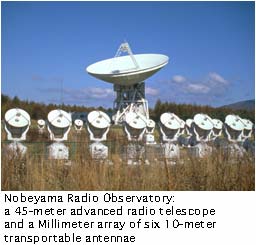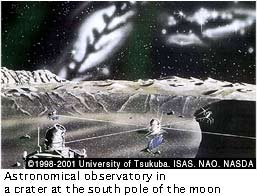 |


File size : 3.4MB
Format : MPEG |
|
Q. So, does that mean PR or promotion activities will be more important for gaining a better understanding from the public?
 Yes, absolutely. As far as NAOJ is concerned, we started these activities a long time ago. For instance, the Nobeyama Radio Observatory has always been open to the public, since its opening in 1982. Of course it’s closed at night, after 5 p.m., for safety reasons, but other than that, we welcome anyone, anytime. In fact, the observatory has become a well-known sightseeing spot, and has 100,000 visitors every year. A couple of years ago the total number of public visitors reached 2 million, and I think that’s an incredible number for a museum, even in a big city. Yes, absolutely. As far as NAOJ is concerned, we started these activities a long time ago. For instance, the Nobeyama Radio Observatory has always been open to the public, since its opening in 1982. Of course it’s closed at night, after 5 p.m., for safety reasons, but other than that, we welcome anyone, anytime. In fact, the observatory has become a well-known sightseeing spot, and has 100,000 visitors every year. A couple of years ago the total number of public visitors reached 2 million, and I think that’s an incredible number for a museum, even in a big city.
Astronomy is quite appealing to both adults and children, as is space development. I believe that as we do more promotion, the public’s interest will grow. In fact, the more you do, the more you will need to do. I cannot force people to understand how interesting astronomy is, so I feel obligated to be more creative to meet their requests or demands.
|
 |
 |
 |


File size : 18.4MB
Format : MPEG |
|
Q. What are your expectations for the future?
There are many things. I give more than 20 lectures a year for the public, and recently, I’ve been given a lot of opportunities to talk about life in space.
It was only 20 or 30 years ago that an astronomer was laughed at by his colleagues when he talked about the possibility of life in space. They used to say that a researcher shouldn’t talk about something so unreal. Since then, things have changed a lot.
It is now a well-known fact that, besides the Sun, there are countless numbers of fixed stars, and countless numbers of planets circling them. But we haven’t been able to catch and analyze the light from these planets, except for the ones in our solar system. I think it will take another 20 years or so for a planet like Earth, with land, oceans and a possibility of life, to be found. But various kinds of research for finding such a planet 20 years from now have already started. We already have technology that will potentially be used for that purpose, too. Probably a discovery of a planet like Earth, with a high possibility of plentiful life, will be made in 20 years. Then, wouldn’t we want to build a bigger telescope with all the technologies available at that time?
 I’m proposing the construction of a large-scale astronomical observatory on the Moon. The back of the Moon is good for radio-wave observation, but I’m thinking of the south pole as its location. There is a crater near the pole, in which sunbeams never reach the bottom. The Earth has summer and winter because it rotates around the Sun with its axis angled at 23 degrees, whereas the Moon rotates on an almost perpendicular axis. So imagine a bowl at the south pole of the moon. The rim of the bowl would be a perfect obstacle to prevent sunbeams from reaching the bottom of the bowl. We are assuming that the bottom of the crater is a world of minus 200 degrees centigrade, without any heat from the Sun or radiation from the Earth. There is no air and very little chance of earthquakes; it’s such a quiet world. My dream is to build many large telescopes in it, connecting them with lasers. I’m proposing the construction of a large-scale astronomical observatory on the Moon. The back of the Moon is good for radio-wave observation, but I’m thinking of the south pole as its location. There is a crater near the pole, in which sunbeams never reach the bottom. The Earth has summer and winter because it rotates around the Sun with its axis angled at 23 degrees, whereas the Moon rotates on an almost perpendicular axis. So imagine a bowl at the south pole of the moon. The rim of the bowl would be a perfect obstacle to prevent sunbeams from reaching the bottom of the bowl. We are assuming that the bottom of the crater is a world of minus 200 degrees centigrade, without any heat from the Sun or radiation from the Earth. There is no air and very little chance of earthquakes; it’s such a quiet world. My dream is to build many large telescopes in it, connecting them with lasers.
The Sun is an obstacle to observation, since its extremely strong heat distorts or expands telescopes. The Earth is another hindrance, since it releases a lot of noise, such as radio waves and infrared rays. The bottom of the crater, on the other hand, is a very quiet, spacious plain. By connecting many telescopes with lasers, it would be possible to draw a map of the surface of a planet that is orbiting a fixed star, like the Earth around the Sun. There would be oceans, land, and if a dot of green were recognized on the land, it could be like the rainforest along the Amazon. And, if we selected only the light released from the rainforest, and used a spectroscope, we might find out what spectrum is characteristic of those plants. In 50 years, these things might become possible.
So, I often tell teenagers that, while you are alive, science and astronomy might advance so much that a day will come when they say there is life on that star. Unfortunately, it still wouldn’t be possible to go there by rocket to confirm it. Today’s rockets can travel only as far as our solar system. Technology is not developed enough yet to reach other stars. And besides, it takes hundreds of years for a rocket to reach that far, so anyway, the mission couldn’t be completed in this century. Therefore, I predict that it is astronomy that will take the lead in finding life on another planet. I would say that this is my biggest dream, and the dream will come true when astronomy and space technology marry.
[Interviewed on December 25, 2003]
Images from the National Astronomical Observatory of Japan (NAOJ)
|
|
 |

